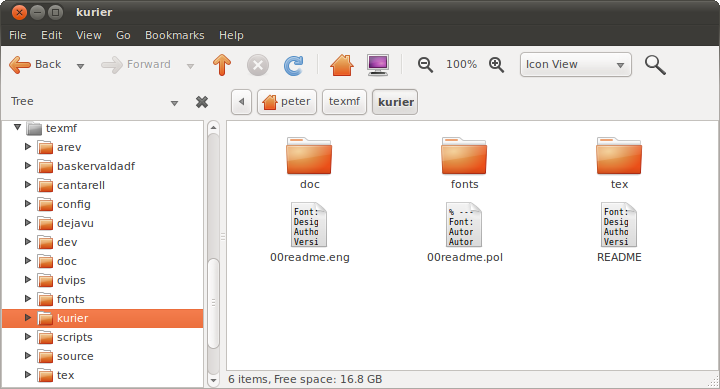The LATEX Font Catalog is a web site created and
maintained by Palle Jørgensen at http://www.tug.dk/FontCatalogue/. It
lists over 200 typefaces for use with LATEX, many of them
available nowhere else, with samples and links to the
directories on CTAN where you can download them. You can spend
many fascinating hours downloading and installing them and
trying them out in your documents.
If no TDS zip file is provided (check
on the typeface’s web page on CTAN at https://www.ctan.org/tex-archive/fonts), you
will need to use the plain zip file and move the
subdirectories into The Right Places yourself.
Installing a font from the Font Catalogue manually
Download the zip file from the link download
the contents of this package in one zip
archive on the typeface’s
CTAN web page, which is either at the
bottom or the right-hand side, depending on the width of
your screen.
Open the zip file in your directory browser
(see row 3 in Table 1 above). Inside the zip file there
will be several subdirectories, shown in
Figure 6.1 below
Figure 6.1: Layout of a font zip file downloaded from
CTAN
You will want three folders: doc,
latex, and
either the
truetype or the
opentype, whichever one is there.
Open the doc zip directory and
check the README or
AUTHORS file to identify the company
or individual responsible for the typeface. This is
commonly called the ‘foundry’,
following the habits of the old hot-metal type era. It
should be one word, or an acronym.
In your Personal TEX
Directory, create places to put these, replacing
foundry and
typeface names with meaningful
one-word values:
| Zip file directory | TDS directory |
| doc | fonts/doc/foundry/typeface |
| latex | tex/latex/typeface |
| opentype¹ | fonts/opentype/foundry/typeface |
| truetype¹ | fonts/truetype/foundry/typeface |
¹ Font zip files normally provide either a
truetype folder or an
opentype folder. If both, pick one.
Extract the contents of each of the three zip folders
in turn into the folders you have created in your Personal TEX Directory
according to the table in step 4 above.
The foundry name is not essential, but it helps to use
a separate folder because it identifies where the fonts
originated, which can help with choosing fonts.
If there was a package (.sty) file in
the latex zip directory, you can use it
in your documents, otherwise load the font[s] you want as
shown in § 6.2.2.2 above.

